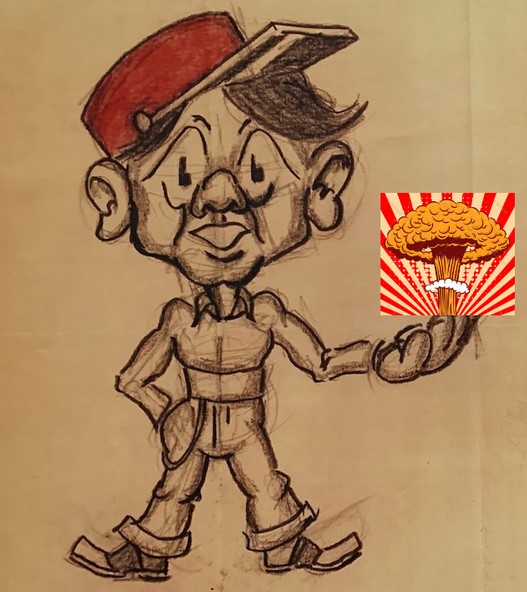
Morning! We are working on the cover for the next publishable project. We write about it every day, and the Chairman thinks a progressive series of the minutia of living through what is going to happen to us will be a fun romp. We will see about that.
We agree that this will be a historic time to which the historians and media will assign a pithy one-or-two word sobriquet. We are using “Life at the Fall of Rome” for a draft title, since a new one may pop out in this endless campaign for power involving our coming Election. The perplexed-looking fellow is from one of Dad’s sketches, undated, though the (not included) caption is to a woman named “Helen,” who may have been a romantic interest in 1946 or so. That was the year after two atomic devices ended something horrific.
You know Arrias, an astute Old Salt who is a regular contributor to the Socotra House Daily maundering. In addition, he does a regular column on the events and progress of the now two-year-long Ukrainian conflict. He writes with crisp military precision learned long ago, and the little villages with unpronounceable names on the banks of two big rivers in the east that has enabled us to follow the course of fighting in all four seasons.
Right now, both sides they are doing military operations in the mud, and that will go on possibly until May. His format is to cover the numbers in terms of air and ground combat, the status of aid and exports and then concludes with a piece he calls “Thoughts.” That is normally a couple perceptive paragraphs on what the summary of current events means to what is coming next.
Yesterday’s assessment was bleak and startling. There has been a panoply of alarming information warfare in progress. We are inundated in it, as you are well aware. It has included description of a series of what are called “Red Lines,” some of them drawn (and ignored) in sandy places like Syria. Russia’s propaganda has featured periodic reminders that the Kremlin possesses 6,000 atomic devices.
Arrias reported yesterday there are some new ones, the color lost in the sodden morass of Ukrainian mud. But these come direct from Mr. Putin, and they are a quite palpable reminder that things could quite abruptly go sideways in this struggle. This is what Arrias was considering on the news of it:
“Russian forces are still making some progress despite the blooming mud season. Despite their success on the ground, Putin felt it necessary to make a comment about both negotiations and nuclear weapons.”
We don’t know about you, but nukes have a certain resonance here in the Writer’s Section. We were involved in the command-and-control system that protected our atomic devices while also keeping them ready for immediate use if ordered.
We mostly dealt with the ether’s electrons that told us what to do with them. We only saw a real one once, sleek, white painted with a blue tip. It’s power- and horror- was reflected by it’s streamlined shape resting on a cradle on a steel deck. It was on the hangar bay deck, awaiting a transfer from a vault on the ship for a loading drill. A young Marine was on guard, authorized to use his M-16 as “deadly force” if he felt things were not in order.
That was an old memory from another struggle, or maybe the same one that persists today. But the topic of nukes that came from the Kremlin yesterday are more stark than usual braggadocio Perhaps it is Putin’s upcoming re-election, voting for which starts on Friday. Like our recent elections, the result has been pre-determined so there will be no surprises. Putin is guaranteed to win it, but the charade is deemed necessary.
So, it’s a little hard to separate campaign rhetoric in Moscow from the chaos of the one happening here.
Arrias notes that some of NATO members (France and Lithuania) have publicized discussions on the dispatch of troops to the trouble, and potential “red lines” for their use. Putin felt the need to respond with his own stick dragged across the mire of combat. His statement outlined “what activities conducted by someone else he would consider as escalatory, and, if carried on long enough or to a great enough extent, would constitute a threat to Russia.”
There was something ambiguous about the tone of the statement. Putin could be bluffing, but he’s not telling a falsehood. It seems a fair assessment that he would consider NATO troops, openly on the ground in Ukraine, as a direct threat to Russia. A response to that would- not “could” include use of nuclear weapons. A demonstration first? Or something intended to be massive and decisive?
Whichever it is, this appears to be a declaration of an actual red line.
Arrias notes it may exist only in Putin’s head, but it is real. The response from the other side of our big River seems to contain a readiness to brush off his statement as simply bluster. But it should be considered that he might be actually be telling the world exactly what he is thinking.
Remember the charter in NATO’s Article Five? “An attack on one is an attack on all?”
Despite some of the rhetoric appealing to keep things in a conventional context, it appears a line in the mud has been drawn. We may actually be approaching a real red line. Depending on how Mr. Putin feels he is doing, we may be on our way to an inadvertent crossing.
We have only met the gaze of someone willing- and authorized- to kill us over a red line and a nuclear weapon that one time. But the memory stays with us, you know? It is a little chilling. And it is closer than we recall.
Copyright 2024 Vic Socotra
www.vicsocotra.com
